Patient Dismissal Letter
Dear [Patient's Name],
Re: Patient Dismissal
I hope this letter finds you well. I am writing to inform you that, after careful consideration, we have made the difficult decision to dismiss you as a patient from [Medical Practice/Organization Name]. This decision was reached after a thorough review of your medical records, interactions, and overall treatment history.
We understand that this news may come as a surprise, and we would like to take this opportunity to explain the reasons behind our decision. Despite our best efforts, we have encountered significant challenges in providing the level of care necessary to meet your medical needs. These challenges include [provide specific reasons for dismissal, such as non-compliance with treatment plans, missed appointments, inappropriate behavior towards staff, or any other relevant issues].
As healthcare professionals, it is our primary responsibility to ensure the well-being and safety of our patients. In order to maintain a safe and effective environment for all patients, it is essential that we uphold certain standards of behavior and adherence to treatment plans. Unfortunately, we have determined that we are unable to meet your needs within the framework of our practice.
We understand that continuity of care is crucial, and we want to assist you in finding alternative medical providers who may better suit your needs. Therefore, we strongly recommend that you seek healthcare services elsewhere. We would be happy to provide you with a list of healthcare providers in the area who may be better suited to address your medical concerns.
Please note that your medical records will remain confidential and will be transferred to your new healthcare provider upon your written request and authorization.
If you require any prescription refills or ongoing medical support during this transition period, please contact our office within the next [number of days] to make the necessary arrangements.
We genuinely regret any inconvenience this decision may cause you, but we believe it is in the best interest of both parties. We wish you the best of luck in finding a healthcare provider who can meet your medical needs effectively.
If you have any questions or need further assistance, please do not hesitate to contact our office. We are here to help guide you through this transition and ensure a smooth transfer of your medical records.
Sincerely,
[Your Name]
[Your Title/Position]
[Medical Practice/Organization Name]
Patient Dismissal for Non-Payment - Professional
Subject: Notice of Termination of Patient-Physician Relationship
Dear [Patient Name],
After careful consideration, I am writing to inform you that I will no longer be able to continue as your healthcare provider effective [Date - typically 30 days from letter date]. This decision has been made due to outstanding balances on your account totaling $[Amount] that have remained unpaid despite multiple billing statements and attempts to arrange payment.
I understand that financial difficulties can arise, and I have made every effort to work with you regarding payment arrangements. However, the continued non-payment has made it necessary for me to terminate our professional relationship.
To ensure continuity of your care, I will continue to provide emergency medical services for the next 30 days. During this transition period, I strongly encourage you to establish care with another physician. I am happy to provide you with referrals to other practitioners in the area if needed.
Upon your written authorization, I will forward copies of your medical records to your new physician. Please note that there may be a reasonable fee for copying extensive records as permitted by state law.
If you have any questions or wish to discuss this matter further, please contact our office at [Phone Number].
Sincerely,
[Physician Name]
[Medical License Number]
[Practice Name]
Patient Dismissal for Non-Compliance - Formal
Subject: Termination of Patient Care Due to Non-Compliance
Dear [Patient Name],
This letter serves as formal notification that I am terminating our physician-patient relationship, effective [Date - 30 days from letter date]. This decision has not been made lightly and follows multiple documented instances of non-compliance with prescribed treatment plans.
Specifically, you have repeatedly failed to follow medical recommendations including: [list specific examples such as "take prescribed medications as directed," "attend scheduled follow-up appointments," "complete recommended diagnostic testing," etc.]. Despite numerous discussions about the importance of adherence to your treatment plan, these patterns have continued.
As a physician, I have an obligation to provide you with the best possible care. However, when treatment recommendations are not followed, it becomes impossible for me to effectively manage your health conditions and ensure positive outcomes.
For the next 30 days, I will remain available to treat you for emergency medical conditions only. I strongly urge you to find a new healthcare provider immediately to ensure there is no gap in your care. I can provide you with names of other physicians in the area who may be accepting new patients.
Your medical records will be transferred to your new physician upon receipt of a written authorization from you.
Should you need to contact our office during this transition period, please call [Phone Number].
Respectfully,
[Physician Name], [Credentials]
[Practice Name]
Patient Dismissal for Disruptive Behavior - Serious
Subject: Immediate Termination of Patient-Physician Relationship
Dear [Patient Name],
I am writing to inform you that I am immediately terminating our physician-patient relationship, effective [Date]. This decision follows the incident that occurred on [Specific Date] when you [describe behavior: verbally abused staff members, made threatening statements, created a hostile environment, etc.].
I have a responsibility to maintain a safe and professional environment for my staff and other patients. Your behavior on [Date] was unacceptable and will not be tolerated. Additionally, this was not an isolated incident, as there have been [Number] previous documented occasions where similar concerns were raised about your conduct.
Due to the severity of this situation, I am providing you with [15/30] days to secure alternative medical care. During this limited period, I will be available only for true medical emergencies. I strongly recommend that you establish care with another provider immediately.
Please contact [Name of Medical Records Coordinator] at [Phone Number] to arrange for the transfer of your medical records to your new physician. A signed authorization form will be required.
I sincerely hope that you will approach future medical relationships with respect and professionalism.
[Physician Name]
[Medical License Number]
Patient Dismissal Due to Physician Retirement - Heartfelt
Subject: An Important Update About My Retirement
Dear [Patient Name],
It is with mixed emotions that I write to inform you of my decision to retire from medical practice. My last day of seeing patients will be [Date], and I will be closing my practice effective [Date].
After [Number] years of practicing medicine, it is time for me to step back and spend more time with my family and pursue other interests. This has been an incredibly difficult decision, as caring for patients like you has been the greatest privilege of my professional life.
I want to express my deepest gratitude for allowing me to be part of your healthcare journey. It has been an honor to serve you and your family, and I will carry the memories of our time together with great fondness.
To ensure continuity of your care, I am working to help all of my patients transition smoothly to new providers. [Dr. Name/Practice Name] has agreed to accept my patients, and I believe they will provide you with excellent care. Alternatively, I can provide you with a list of other highly qualified physicians in the area.
I will remain available until [Date] for any urgent medical needs and to assist with your transition. Your medical records will be transferred to your new provider upon your written authorization, or they will be stored securely for [Number] years as required by law.
Thank you for your trust, your kindness, and for being such a wonderful patient. I wish you all the best in your continued health and happiness.
With warm regards and best wishes,
[Physician Name]
Patient Dismissal Due to Practice Closure - Professional
Subject: Important Notice - Practice Closure
Dear [Patient Name],
I am writing to inform you that [Practice Name] will be closing permanently on [Date]. This decision was made due to [reason: relocation, changes in healthcare landscape, personal circumstances, etc.], and I deeply regret any inconvenience this may cause you.
All patient appointments scheduled after [Date] will need to be cancelled. Our staff will be contacting you directly to assist with rescheduling any upcoming appointments with alternative providers.
Your medical records will be maintained and stored securely for [Number] years in accordance with [State] law. To obtain copies of your records or to have them transferred to a new provider, please contact our office at [Phone Number] or email [Email Address]. We will process all record requests at no charge through [Date].
I want to thank you sincerely for choosing our practice for your healthcare needs. It has been a privilege to serve you, and I am committed to making this transition as smooth as possible.
If you need assistance finding a new healthcare provider, please let us know and we will be happy to provide recommendations.
Sincerely,
[Physician Name/Practice Administrator]
[Practice Name]
[Phone Number]
Patient Dismissal for Missed Appointments - Formal
Subject: Termination of Care Due to Missed Appointments
Dear [Patient Name],
This letter serves as formal notification that I will no longer be able to serve as your healthcare provider, effective [Date - 30 days from letter date]. This decision is due to a pattern of missed appointments without proper notice or cancellation.
Our records indicate that you have missed [Number] scheduled appointments over the past [Time Period], including appointments on [list specific dates]. Each missed appointment prevents another patient from receiving timely care and creates inefficiencies in practice operations.
Despite previous reminders about our cancellation policy and the importance of keeping scheduled appointments or providing adequate notice, this pattern has continued. Effective medical care requires consistent communication and follow-through from both patient and provider.
For the next 30 days, I will remain available for emergency medical care. I encourage you to establish a relationship with a new healthcare provider as soon as possible. I can provide referrals to other physicians in the area if you would like.
To transfer your medical records to your new provider, please submit a written authorization to our office. You may contact us at [Phone Number] with any questions.
I wish you well in your future healthcare.
Sincerely,
[Physician Name]
[Credentials]
Patient Dismissal for Inappropriate Relationship Boundaries - Official
Subject: Termination of Patient-Physician Relationship
Dear [Patient Name],
I am writing to formally notify you that I am terminating our physician-patient relationship, effective immediately. This decision has been made due to repeated attempts to establish an inappropriate personal relationship that extends beyond the professional boundaries of medical care.
Despite my previous verbal communications regarding the need to maintain professional boundaries, you have continued to [describe behavior: make personal advances, contact me outside of professional channels, make inappropriate comments, etc.]. This creates an untenable situation that compromises my ability to provide you with objective medical care.
Given the circumstances, I am providing you with [15] days to secure alternative medical care. During this time, I will be available only for genuine medical emergencies. I strongly recommend that you establish care with another physician immediately.
Your medical records will be transferred to your new provider upon receipt of written authorization. Please contact our office at [Phone Number] to arrange this transfer.
I trust you understand the importance of maintaining professional boundaries in all future medical relationships.
[Physician Name]
[Medical License Number]
[Date]
Patient Dismissal for Substance-Seeking Behavior - Serious
Subject: Termination of Patient Care
Dear [Patient Name],
I am writing to inform you that I can no longer serve as your healthcare provider, effective [Date - 30 days from letter date]. This decision has been made due to documented patterns of behavior that suggest medication-seeking for purposes other than legitimate medical treatment.
Specifically, our records show: [examples: multiple early refill requests, reports of lost medications, requests for specific controlled substances, obtaining prescriptions from multiple providers, etc.]. These patterns are concerning and suggest a potential substance use disorder that requires specialized treatment beyond what I can provide in this practice setting.
I am genuinely concerned about your wellbeing and strongly encourage you to seek help from addiction medicine specialists or treatment programs. I can provide you with referrals to appropriate resources including [list resources: addiction treatment centers, substance abuse counselors, support groups, etc.].
During the next 30 days, I will be available for emergency medical care only. I will not be prescribing controlled substances during this transition period. Please establish care with a new provider as soon as possible.
Your medical records will be transferred to your new physician upon your written request.
If you are ready to seek help for substance use concerns, please call [Phone Number] and we can provide you with appropriate referrals and support.
[Physician Name]
[Credentials]
What is a Patient Dismissal Letter and Why is it Needed
A patient dismissal letter is a formal written notification from a healthcare provider to a patient stating that the physician-patient relationship is being terminated. This legal document serves multiple critical purposes:
- Legal protection for the healthcare provider against potential abandonment claims
- Documentation of the termination for medical and legal records
- Communication of the reasons for dismissal and transition timeline
- Continuity of care by providing adequate time for the patient to find alternative healthcare
- Professional closure of the therapeutic relationship in a documented manner
The letter is essential because healthcare providers have both legal and ethical obligations when ending a patient relationship, and verbal notification alone is insufficient for legal protection.
Requirements and Prerequisites Before Sending a Patient Dismissal Letter
Before issuing a patient dismissal letter, healthcare providers must ensure the following conditions are met:
- Document all incidents that led to the decision (missed appointments, non-payment, non-compliance, behavioral issues)
- Attempt resolution through verbal warnings, payment plans, or behavioral counseling when appropriate
- Verify legal compliance with state medical board regulations regarding patient termination
- Ensure no abandonment by confirming the patient is not in an acute medical crisis or critical treatment phase
- Review employment contract if working for a hospital or group practice to ensure dismissal complies with organizational policies
- Obtain legal review of the dismissal letter, especially in complex situations
- Prepare referral list of alternative providers in the area
- Notify malpractice insurance carrier about high-risk dismissals
- Check for discriminatory factors to ensure the dismissal is not based on protected characteristics
- Confirm record-keeping compliance for maintaining and transferring patient records
When Should a Patient Dismissal Letter Be Sent
Patient dismissal letters should be sent in the following scenarios:
- Financial non-compliance: Persistent non-payment despite billing efforts and offered payment arrangements
- Treatment non-adherence: Repeated failure to follow medical recommendations, take prescribed medications, or attend follow-up appointments
- Disruptive or abusive behavior: Verbal abuse, threats, harassment of staff, or creating unsafe environments
- Missed appointments: Chronic pattern of no-shows without proper notice or valid reasons
- Boundary violations: Inappropriate attempts at personal relationships or stalking behavior
- Drug-seeking behavior: Evidence of medication abuse, doctor shopping, or prescription fraud
- Mutual agreement: When patient and provider mutually determine the relationship is not effective
- Practice changes: Physician retirement, practice closure, relocation, or change in specialty
- Loss of trust: Irreparable breakdown in the therapeutic relationship
- Scope of practice: Patient requires specialized care beyond the provider's expertise
- Insurance changes: Provider no longer accepts patient's insurance and patient cannot pay out-of-pocket
Who Should Send the Patient Dismissal Letter
The patient dismissal letter should come from:
- The treating physician in individual practice settings, signed with medical license number
- The practice medical director or managing physician in group practices
- The senior partner in multi-physician practices for patients seen by multiple providers
- The physician of record who has primary responsibility for the patient's care
- Practice administrator only when the dismissal is purely administrative (practice closure, insurance issues) rather than medical or behavioral
The letter should always be on official letterhead and include the physician's credentials, license number, and contact information for legal validity.
How to Write and Send a Patient Dismissal Letter
The process of writing and sending a patient dismissal letter involves:
- Draft the letter using clear, professional language without emotional content or blame
- State the decision clearly in the opening paragraph without ambiguity
- Provide specific reasons when appropriate, but avoid excessive detail that could be legally problematic
- Specify the timeline for transition (typically 30 days, or 15 days for severe situations)
- Clarify emergency coverage during the transition period
- Include referral information or offer to provide alternative provider names
- Explain record transfer process and any associated fees
- Have legal counsel review the letter before sending, especially in high-risk situations
- Send via certified mail with return receipt requested to document delivery
- Keep copies of the letter and delivery confirmation in the patient's medical record
- Follow up if certified mail is unclaimed or returned
- Document the entire process in the patient's chart with dates and actions taken
To Whom Should the Patient Dismissal Letter Be Addressed
The patient dismissal letter should be addressed to:
- The patient directly as the primary recipient
- Legal guardian or parent if the patient is a minor
- Healthcare proxy or power of attorney if the patient has documented cognitive impairment
- Both patient and guardian when applicable for transparency
- Court-appointed guardian for patients under conservatorship
Additional copies may need to be sent to:
- The patient's last known address and any alternative addresses on file
- Emergency contacts in cases where patient safety is a concern
- Referring physicians as a professional courtesy if the patient was referred
- Insurance companies when required by contract provisions
Formatting Guidelines for Patient Dismissal Letters
Patient dismissal letters should follow specific formatting standards:
- Length: One to two pages maximum; concise and direct
- Tone: Professional, formal, and neutral without anger or accusation
- Medium: Printed letter sent via certified mail with return receipt; keep electronic copies
- Letterhead: Official practice letterhead with complete contact information
- Date: Clearly stated at the top of the letter
- Signature: Original signature in ink (not stamped) with printed name and credentials below
- Font: Professional business font (Times New Roman, Arial) in 11-12 point size
- Language: Clear, simple language avoiding medical jargon and legalese when possible
- Structure: Formal business letter format with proper spacing and margins
- Confidentiality: Marked "CONFIDENTIAL - PATIENT HEALTH INFORMATION"
- Record: File copy in patient's medical record with certified mail receipt attached
Elements and Structure That Must Be Included in a Patient Dismissal Letter
Every patient dismissal letter must contain these essential elements:
- Opening statement: Clear declaration that the physician-patient relationship is being terminated
- Effective date: Specific date when the relationship will end (typically 30 days from letter date)
- Reason for dismissal: Brief, factual explanation without excessive detail
- Emergency care provision: Statement of availability for emergency care during transition period
- Timeline specification: Number of days the provider will remain available
- Alternative provider information: Offer to provide referrals or list of other providers
- Medical records transfer: Instructions for obtaining records and authorization process
- Contact information: Phone number for questions or to arrange record transfer
- Closing: Professional sign-off with physician's full name, credentials, and license number
Optional but recommended elements:
- Documentation reference: Mention of previous discussions or warnings when applicable
- Transition assistance: Offer to communicate with new provider
- Prescription information: Clarification about refills during transition period
- Payment obligations: Reminder about outstanding balances if relevant
What to Do After Sending the Patient Dismissal Letter
After mailing the patient dismissal letter, healthcare providers should:
- Document mailing date and certified mail tracking number in patient's chart
- Monitor mail delivery using tracking to confirm delivery
- Follow up if undelivered: Use alternative contact methods (phone, email) if certified mail is returned
- Prepare for contact: Brief staff on how to handle patient calls or visits
- Maintain emergency availability during the stated transition period
- Be prepared to defend the decision with documentation if challenged
- Transfer records promptly when authorized by the patient
- Keep detailed notes of any post-letter interactions with the patient
- Notify malpractice carrier if the situation is high-risk
- Avoid further engagement beyond emergency care and record transfer
- Consult legal counsel if the patient threatens legal action
- Maintain professionalism in all subsequent interactions
- Archive documentation for the required retention period per state law
Advantages and Disadvantages of Sending Patient Dismissal Letters
Advantages
- Legal protection against abandonment claims and malpractice allegations
- Clear documentation of the termination date and transition period
- Professional closure of a problematic relationship
- Staff safety when dismissing abusive or threatening patients
- Practice efficiency by removing chronic no-show patients
- Focus on compliant patients who will benefit most from care
- Financial improvement by addressing chronic non-payment issues
- Reduced liability in cases of non-compliance or drug-seeking behavior
Disadvantages
- Potential legal challenges if not done properly
- Risk of abandonment claims if timeline is inadequate
- Negative publicity or online reviews from disgruntled patients
- Emotional difficulty for providers who feel responsible for patient welfare
- Time and administrative burden of proper documentation and process
- Potential loss of revenue during transition period
- Ethical concerns about patient access to care, especially in underserved areas
- Relationship with referring physicians may be affected
- State medical board complaints if dismissal appears discriminatory
Comparing Patient Dismissal Letters to Alternative Actions
Patient Dismissal Letter vs. Verbal Warning
- Dismissal letter provides legal documentation while verbal warning has no legal protection
- Letter is final decision while warning offers opportunity for behavioral change
- Letter requires 30-day transition period while warning maintains ongoing care
Patient Dismissal Letter vs. Practice Transfer
- Dismissal terminates the relationship while transfer reassigns to another provider within same practice
- Dismissal requires patient to find new care while transfer maintains continuity
- Dismissal is appropriate for severe issues while transfer works for personality conflicts
Patient Dismissal Letter vs. Mutual Agreement to Terminate
- Dismissal letter is unilateral decision while mutual termination is collaborative
- Dismissal may create conflict while mutual agreement preserves relationship
- Dismissal requires formal process while mutual termination can be more flexible
Patient Dismissal Letter vs. Helping Patient Find Alternative Care
- Dismissal emphasizes termination while assisted transition emphasizes continuity
- Dismissal provides minimum required notice while assisted transition offers active help
- Dismissal is appropriate for serious breaches while assistance works for practice changes
Alternatives to Patient Dismissal
- Payment plans for financial issues
- Care coordination with specialists for non-compliance
- Behavioral contracts for boundary issues
- Group visits for patients needing extra support
- Referral to social services for underlying problems
Common Mistakes to Avoid When Sending Patient Dismissal Letters
- Inadequate notice period: Providing less than 30 days unless emergency circumstances exist
- Dismissing during acute care: Terminating while patient is in active treatment or crisis
- Insufficient documentation: Failing to document incidents leading to dismissal
- Emotional language: Using angry, accusatory, or unprofessional tone
- Excessive detail: Providing too much information that could be used against you legally
- No emergency provision: Failing to specify availability for emergencies during transition
- Verbal-only termination: Not providing written documentation of the dismissal
- Discriminatory dismissal: Terminating based on race, religion, disability, or other protected characteristics
- Improper delivery: Sending via regular mail instead of certified mail with return receipt
- No referral assistance: Failing to offer help finding alternative providers
- Immediate termination: Ending relationship without appropriate transition period (except extreme circumstances)
- Unclear effective date: Being vague about when the relationship ends
- Failing to notify staff: Not informing office personnel about the dismissal
- Continuing to bill: Sending bills without addressing dismissal conversation
- No legal review: Failing to have attorney review letter in high-risk situations
- Missing follow-up: Not documenting delivery confirmation and subsequent events
- Abandoning prescriptions: Failing to clarify medication refill policy during transition
Tips and Best Practices for Patient Dismissal Letters
- Consult your malpractice insurance before dismissing any patient to ensure proper process
- Use templates reviewed by attorneys familiar with medical practice in your state
- Keep emotion out of it: Stick to facts and maintain professional tone throughout
- Be specific about dates: State exact effective date, not "30 days from receipt"
- Offer genuine assistance: Provide actual referrals rather than generic suggestions
- Time it appropriately: Avoid dismissing just before holidays or during health crises
- Train your staff: Ensure everyone knows how to handle interactions with dismissed patients
- Double-check delivery: Use both certified mail and regular mail for better chance of receipt
- Consider a phone call: Follow up the letter with a brief, professional phone conversation when appropriate
- Maintain boundaries: Don't get drawn into arguments or negotiations after sending the letter
- Keep detailed records: Document every interaction and decision in the patient's chart
- Review state regulations: Each state has different requirements for patient termination
- Consider the patient's vulnerabilities: Take extra care with elderly, disabled, or mentally ill patients
- Notify hospital privileges office if dismissing a patient you may encounter in hospital settings
- Be consistent: Apply your dismissal criteria uniformly to avoid discrimination claims
- Plan for worst case: Have security protocols ready for potentially volatile situations
- Follow through completely: Honor all commitments made in the letter regarding emergency care and records
Frequently Asked Questions About Patient Dismissal Letters
Can I dismiss a patient immediately without notice? Generally no, except in extreme circumstances such as physical threats, violence, or stalking. Most situations require 30 days notice.
What if the patient has an upcoming surgery or is pregnant? You cannot dismiss a patient in the middle of acute care. Wait until the acute episode resolves or the pregnancy is completed before initiating dismissal.
Do I need to give a reason for the dismissal? It's generally advisable to provide a brief, factual reason, but avoid excessive detail. Some attorneys recommend minimal explanation to reduce legal risk.
What if I'm the only specialist in the area? This creates additional ethical obligations. Consult your medical board and consider alternative solutions like behavioral contracts before dismissal.
Can a patient sue me for dismissing them? Yes, patients can sue for abandonment if proper procedures aren't followed, or for discrimination if they can prove the dismissal was based on protected characteristics.
How long must I keep the patient's records after dismissal? Follow your state's retention requirements, typically 7-10 years for adults, longer for minors.
What if the patient refuses to find another doctor? You are not responsible for the patient's actions after providing adequate notice and resources. Document your efforts.
Should I charge for copying medical records? You may charge reasonable fees as permitted by state law, but consider waiving fees during dismissal transitions as good faith gesture.
Can I dismiss a patient who threatens to sue me? Yes, but document carefully and ensure the dismissal isn't retaliatory. Consult legal counsel before proceeding.
What about controlled substance prescriptions during the transition? Specify your policy clearly in the letter. Typically, only emergency prescriptions with no refills during the transition period.

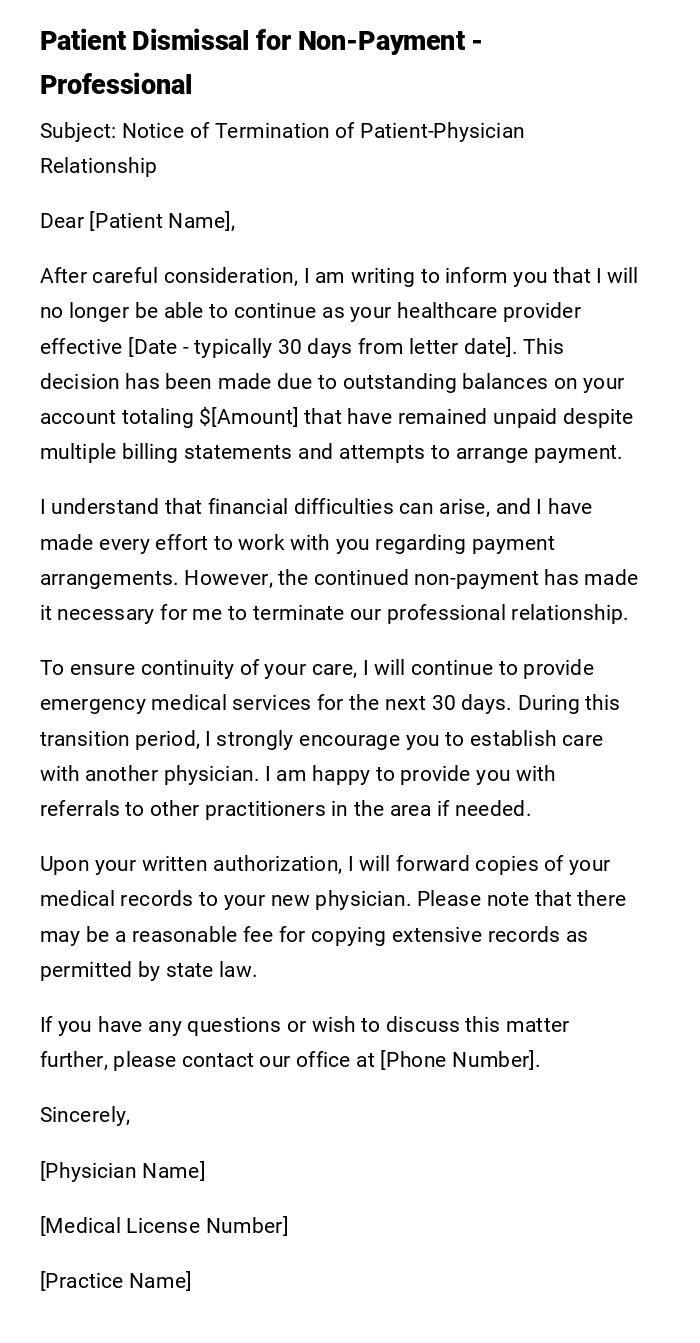
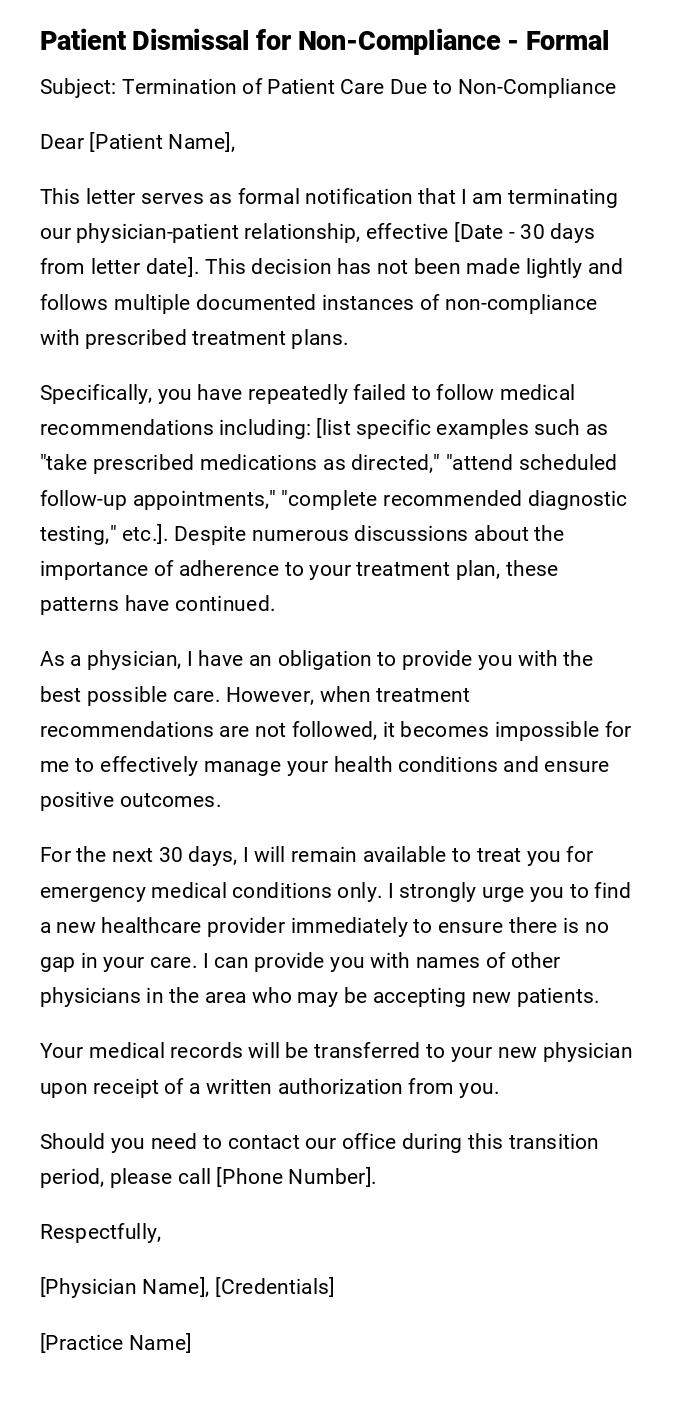
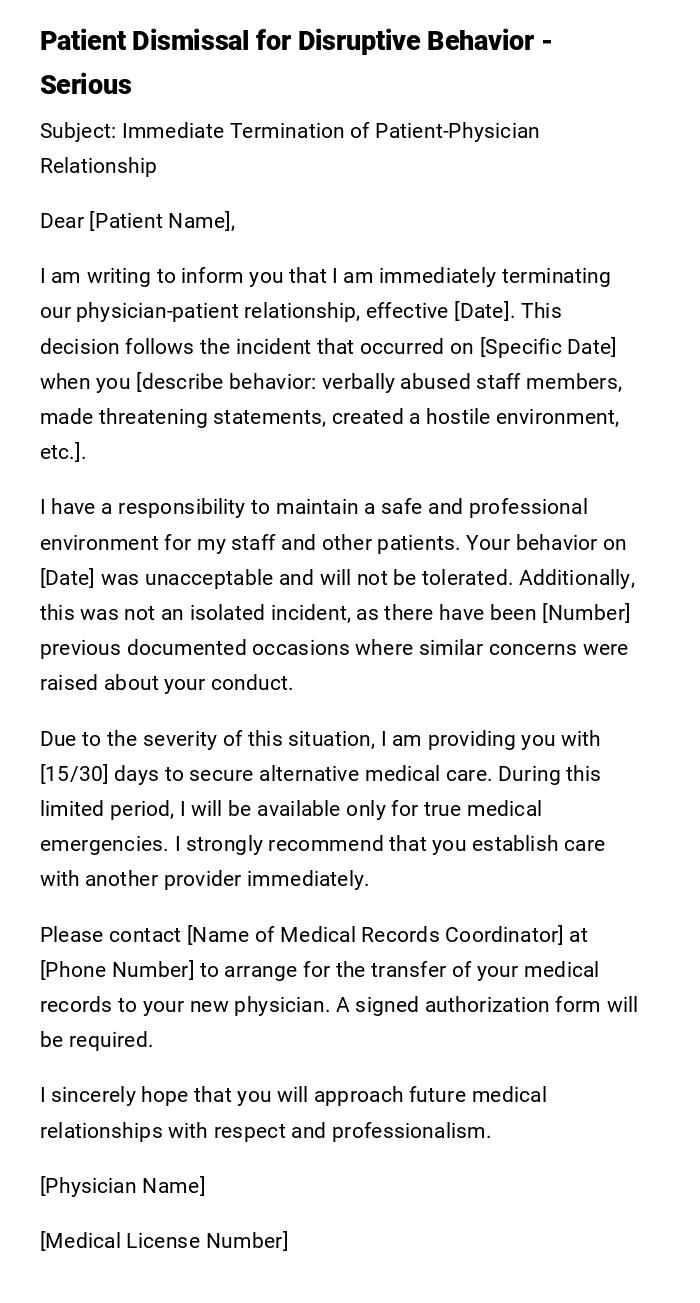
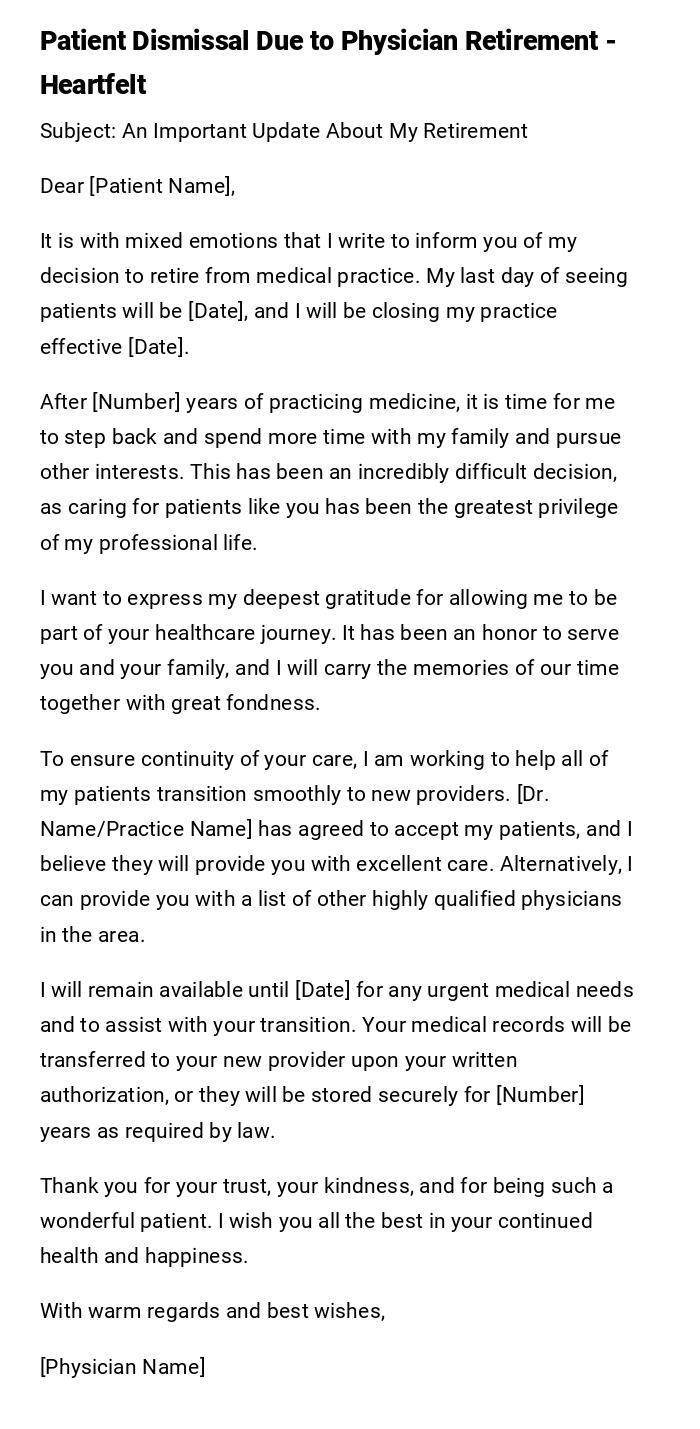

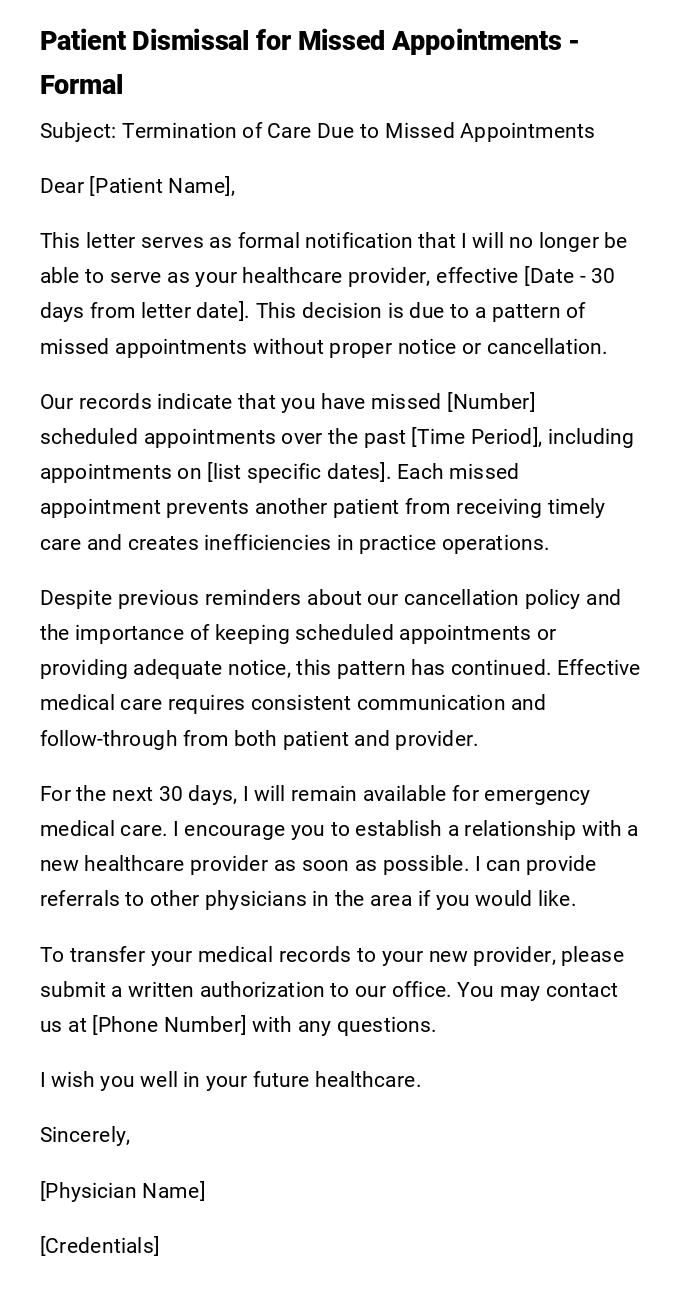
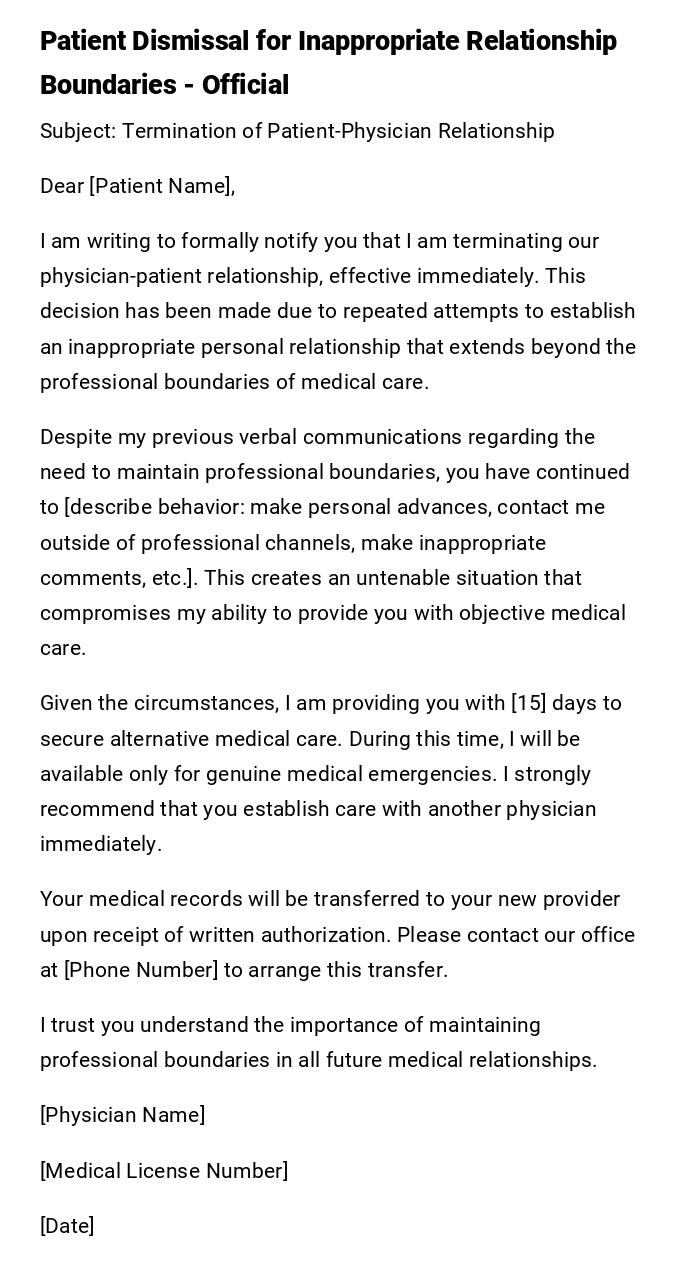
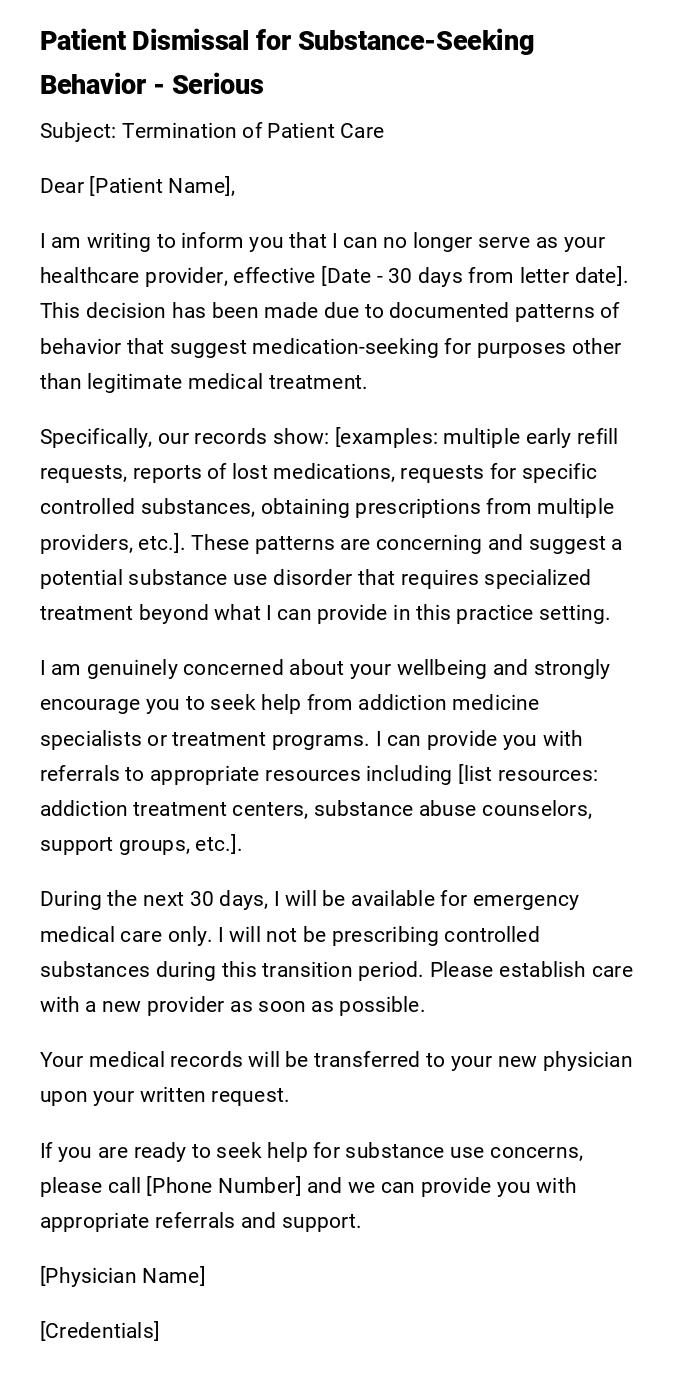

 Download Word Doc
Download Word Doc
 Download PDF
Download PDF